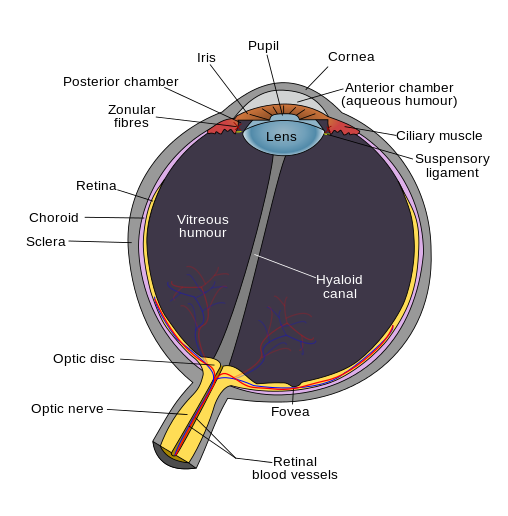If we were to ask you to name different parts of the human eye, chances are that you would quickly think about the retina. The term “retina” refers to an extremely important membrane that sits on the back of our eye. This light-sensitive membrane is what transforms the light energy being perceived by our eyes into electrical signals; these signals then travel along the optic nerve to our brain, where the signals are interpreted and transformed into a visual picture. Without the retina, it would be impossible for us to see anything.
Unfortunately, like any part of our body, our retina can be damaged in the right circumstances. One of the worst things that can develop is retinal detachment – a condition that’s classified as a medical emergency. Because retinal detachment is so devastating, it’s important to understand its causes and symptoms so you can recognize if it’s developing in your own eyes.

What Causes Retinal Detachment?
Retinal detachment happens when the retina is lifted or pulled from its usual position inside the eye, resulting in the loss of its functionality. The development of retinal detachment can be attributed to various factors, including different types of retinal detachment and associated risk factors.
Rhegmatogenous retinal detachment
Retinal detachment occurs when fluid in the eye leaks through an existing tear or break in the retinal membrane. Once this happens, the liquid can separate the membrane from the retinal pigment epithelium (RPE). This type of detachment – which pulls the retina from its key source of nourishment and can destroy the retina’s connection to other important parts of the eye – is the most common type of retinal detachment.
A retinal tear occurs when fluid in the eye leaks through an existing tear or break in the retinal membrane. This can lead to the separation of the membrane from theretinal pigment epithelium (RPE), resulting in a detached retina. This type of detachment, known as retinal detachment, is the most common form and can jeopardize the retina's connection to other crucial parts of the eye, affecting its nourishment and overall function.
Tractionalretinal detachment
Retinal detachment is a type of detachment that is less common. It usually happens when scar tissue in the eye contracts. As the scar tissue moves, it can cause the retina to separate from the retinal pigment epithelium (RPE). This detachment, like rhegmatogenous retinal detachment, disrupts the flow of nourishment to the retina by cutting off the blood vessels. Consequently, the retina cannot function properly. When it comes to retinal detachment treatment, it is important to consider factors such as the presence of posterior vitreous detachment.
Exudative retinal detachment
Retinal detachment surgery is a procedure performed when the eye becomes infected, injured, or traumatized. It is commonly associated with conditions such as lattice degeneration. An exudative retinal detachment, on the other hand, occurs when fluid from the eye leaks beneath the retina without major tears or breaks in the retina.
While retinal detachments are more prevalent in individuals over the age of 40, they can affect people of all ages and genders. Several factors increase the risk of developing this condition. Nearsightedness, previous retinal detachment, family history, previous traumatic eye injury, and coexisting eye diseases or disorders are all associated with a higher likelihood of retinal detachment.
In certain cases, retinal detachment surgery may be necessary to address the condition and restore eye health. It is crucial to promptly seek medical attention if any symptoms or risk factors are present.
How Will I Know If I Have Developed A Retinal Detachment?
As mentioned earlier, retinal detachments are considered a medical emergency by the medical community. Without prompt treatment, retinal detachment can lead to partial or permanent vision loss. It is crucial for people to learn how to recognize the symptoms of retinal detachments in order to prevent this condition.
Patients experiencing a retinal detachment often start seeing floaters or flashes of light. Some patients may notice an increase in the number of floaters or flashes over time, while others may suddenly see a large number of them. Additionally, patients may perceive a 'curtain' obstructing their field of vision and experience a darkening in their peripheral vision.
If you notice any of these symptoms, it is important to seek immediate care from an eye care professional. Depending on the type and severity of the detachment, patients may require a combination ofcommon treatments for retinal detachment.
By recognizing the retinal detachment symptoms and seeking timely treatment, we can work towards how to prevent retinal detachment and preserve vision.
Can I Prevent A Retinal Detachment From Occurring?
The #1 way to prevent a retinal detachment is to regularly visit with your eye doctor for basic eye exams. During these exams, your eye doctor will be able to check your eye for problems that could lead to a retinal detachment later on. Treating these developing issues can sometimes help to prevent a detachment from occurring in the future. Outside of your doctor’s office, you should also wear proper eye protection during sports or at work (if necessary) to protect your eyes from potentially traumatic events or accidents, as these events always raise your risk of developing a retinal detachment.
While retinal detachments can be scary to think about, regularly visiting your eye doctor and immediately reporting any symptoms that could be a sign of trouble will go a long way in keeping your eyes healthy. If, however, you want to visit with your doctor to ask additional or more specific questions about what you can do to take care of your eyes, or to discuss your risk of developing a condition such as retinal tears detachment, we encourage you to make an appointment and visit with us so we can address your concerns.
*Image courtesy of commons.wikipedia.org
